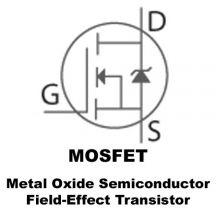A transistor is an element designed to amplify, generate, and also convert electrical vibrations. Transistors are of two types: bipolar and field.
A bipolar transistor is a semiconductor device consisting of two pn junctions. The elementary transistor is built on a germanium crystal, it has two points: an emitter and a collector that touch the surface of the crystal, separated from each other by a distance of 20-50 microns. In other words, one junction connects the emitter to the base (it is called the emitter junction), and the second connects the collector to the base (it is called the collector junction). Bipolar transistors are divided into two types: pnp and npn.
A field effect transistor is a semiconductor device in which the control is carried out by changing the field, unlike bipolar elements, where the output current value is determined by the change in the incoming current. Field devices are single-gate and multi-gate.
The circuit diagram of the transistor is shown in the photo below. The diagram of the bipolar element is a short base line, it symbolizes the base into which two oblique lines enter at an angle of 60 0 and 120 0 , the line with the arrow is the emitter, the second is the collector. The direction of the arrow indicates the type of instrument. The arrow pointing to the base is a pnp type transistor , from the base - npn.
A trait perpendicular to the base is the base electrode. The emitter conductivity value must be known for the correct connection of the transistor to the power source. For pnp type devices, the collector and base must be supplied with a negative voltage of the transistor, and npn type - positive.
Field-effect transistors in the diagrams are indicated as follows: the gate is usually shown with a dash parallel to the channel symbol, the channel conductivity is shown by an arrow placed between the source and drain. If the arrow points in the direction of the channel, then this means that the element belongs to the n-type, and if in the opposite direction, then to the p-type. The image of a field effect transistor with an induction channel is characterized by three short strokes. If the field device has several gates, they are shown with short dashes, the line of the first shutter is always placed on the extension of the source line.

In conclusion, we add that such a name was not immediately fixed to transistors, they were originally called semiconductor triodes (similar to lamp technology). So the transistor is a triode, which is a controlled element, it has been widely used in pulse and amplification circuits. The absence of heat, reliability, small overall dimensions and cost - these are the main advantages of these devices, thanks to which transistors were able to displace electronic lamps from many branches of technology. The main advantage of semiconductor devices is the absence of an incandescent cathode, which consumes significant power and also takes time to heat up. In addition, the transistor is many times smaller than an electric lamp and is able to operate at a lower voltage. All this allowed to significantly reduce the size of electronic devices.